On May 11, 2019, I finished Ironman Santa Rosa. A 2.4-mile swim, 112-mile bike, and 26.2-mile run; 9 months of training for a race that would be over in about 12 hours.
During this time, a few friends asked me how I was preparing, so I’ve written this post in hopes that it helps them—or another online passerby—with their Ironman training. It ended up being longer than I expected, but hopefully it’s thorough. It’s my attempt at summarizing 9 months of thought and research in a post.
For navigation, it is organized as follows:
Motivation
I signed up to race in Ironman Santa Rosa on July 20, 2018. I had never done a triathlon before, or a marathon, or a century ride, or anything more than a casual swim in the pool; neither a complete triathlon nor any of the component parts that make up a full Ironman-distance event. My longest race was a half marathon in San Francisco.
So why did I decide to do this? Honestly, I don’t have a great answer. I thought at some point in my life I might like to, so might as well just do it now and force myself to get fit. You can also delay your participation in Ironman events by a year after registering, so in reality I actually had two years to prepare if needed. But that’s cheating and no fun :)
Spoiler alert: it all worked out. Although in hindsight, signing up on a whim was probably not the best decision.
First, it would have been helpful to work my way up; to, at the very least, participate in a sprint or olympic triathlon first and get the feel of what it’s like to do all three sports in succession.
Second, it’s expensive. The Ironman events themselves are pricey, and then you have to factor in all the equipment on top (bike, bike fit, bike gear, bike shoes, running shoes, wetsuit, swim gear, nutrition, …). To buy all this in a short time span—especially without any validation that I actually liked the sport—was expensive, but mostly just a cost of stupidity.
Finally, I somewhat underestimated the time commitment. I researched the number of hours training would take, but I didn’t really understand what that felt like day-to-day. A simple one-hour swim, for example, is actually 2.5 hours in NYC when you have to walk to the gym and back, wait for a lane at the pool, rotate out of said lane after 30 minutes because there is a waiting list, and then finish off the other 30 minutes of your workout after again waiting for a new lane. A 14-hour training week is 14 hours of workout time, but in reality it’s probably closer to 20 or 25 hours of calendar time. Understanding this before would have been helpful, but I slowly learned to plan for this over time. Also, my weekly training hours were never this high.
Goal
After signing up for the event and getting a sense of my base fitness, I started to have an idea of what my goal for the race would be. First and foremost, it would be to finish. But I also wanted to place above average, which according to Google is 12 hours and 30 minutes.
I don’t know why I chose this arbitrary time; being entirely truthful, I think it’s because I didn’t like the idea of finishing below average. I recognize that races (at the non-professional level) are—and should be—entirely against yourself, but I’m just being honest with my motivations here. I should have chosen this time with more intention.
Training
Base Fitness
As mentioned, the longest race I had ever done before the Ironman was 13.1 miles, a half marathon in San Fransisco. I had also never done any combination of the events in the same session (e.g. a bike ride and then a run). Prior to beginning training in September, 2018, the longest distance of each event I had ever completed was:
| Event | Race Experience | Longest Distance (Race or Otherwise) |
|---|---|---|
| Swim | None | 50m (two pool lengths) without pause |
| Bike | None | 36.86 miles (3:13:38) |
| Run | Half-Marathon | 13.1 miles (1:31:01) |
As you can tell, swimming was not my strong suit. I had okay form, but had never really swam laps, which is quite different from casually swimming in the pool or ocean.
Training Notions
I had some baseline notions about my own fitness level, strengths, weaknesses, etc. that I think were important to build before making my own training plan:
- Running was my strength. “Get me out of the water and off the bike, and I’ll be fine,” I thought. Training here would matter the least (sadly, because running also requires the least amount of wasted time and money).
- Swimming would start off the worst, but improve quickly. I had read that, at first, it’s very common to be out of breath quickly while swimming. Your running endurance won’t transfer immediately, but after learning proper breathing technique and swimming for a few weeks, two laps will quickly become 20.
- I’d spend some time getting the technique right for swimming before worrying about distance or time.
- The bike is the most important part of the race. It’s about half the entire race in terms of time, so you can shave off the most time quickly by improving this event. That is, if I could improve 10% in any event, that would equate to 6-9 min on the swim, 33-42 min on the bike, or 18-24 minutes on the run. Time to buy a bike!
- Either swimming or biking would be the hardest of the three events for me, but biking mattered more.
Keeping these few things in the back of my mind helped me get started, plan for my race, and most importantly, structure my training throughout the 9 months. For anyone starting their own training, I’d highly recommend getting a good sense of your baselines and goals before even signing up for the race, but after works too I guess.
Training Schedule
First off, there really isn’t a one-size-fits-all plan; it depends on your base fitness, your training response, and—most importantly—your life (kids? crazy work hours? live in NYC where every swim takes 100x longer than it should?).
I did not have a coach at any point during training, so most of the workouts and plans were from free resources I found online. On TrainingPeaks, you can find an abundance of training plans , especially paid ones, but I ended up using three free plans from USA Triathlon and rolling them into one another in succession:
- “USA Triathlon Olympic-distance: Intermediate 12 Week Plan"
- "USA Triathlon 70.3 Base Period: 12 Week Plan"
- "USA Triathlon 140.6 Base Period : 12 Week Plan”
Using these on TrainingPeaks was great; each workout included notes, drills, and times, and they were automatically added straight into the TrainingPeaks calendar.
I also used a few workouts from Beginner Triathlete’s “Free Beginner Full Ironman Training Plan,” which has PDF workout sheets for each week of a 20-week Ironman training schedule. I used these as an occasional cross reference for when I felt like the USA Triathlon schedule wasn’t ramping up in difficulty enough. I’d say the Beginner Triathlete plan is slightly larger in training volume compared to the USAT plans.
For swimming, I watched a bunch of YouTube videos to learn proper technique, especially early on in training. My gym’s pool is 17 yards (yes, you read that correctly) and has a 30-minute cap if there’s more than six people, so lots of turns and waiting around! As for swim aids, I purchased a freestyle snorkel and my pool has pull buoys, fins, and paddles, all of which I used at some point or another.
For cycling, I rode most of my training rides in the first half of training on a spin machine at the gym and then indoors on a Wahoo Kickr with Zwift once I purchased a bike. It was pretty cold out in NYC for most of the training season, so only once it became nice outside did I have a chance to practice outdoors. Even so, riding in NYC is horrible, so I usually opted for indoor training wherever possible, which ultimately hurt because I wasn’t comfortable riding safely in aero position and only did so for approximately 1% of Ironman Santa Rosa.
For running, it was pretty straightforward. Unless it was super cold outside and I was forced to be on the treadmill, I ran outdoors on the mostly flat Manhattan East/West side paths.
All that said, below is an export of my TrainingPeaks workouts from when I started training on September 3, 2018 to race day on May 11, 2019. You’ll notice a few things:
- Monday was my easy/rest day, in addition to the other days that I cheated on my training. I used Mondays as a chance to do light strength training and stretching.
- I went very light on training from December 9th to January 16th because of a quad injury and knee pain. I mostly swam during this (incredibly frustrating) time, because running and cycling both hurt. I started physical therapy after this injury and began incorporating quad and glute strengthening exercises, which I continued to do every Monday.
- After March 8th, I started using the Beginner Triathlete plans because I thought they were better for both the max training load weeks and the taper weeks.
- The Apple Watch, when synced with TrainingPeaks, does not count rest time or kicking drills during swim workouts, only active swim stroke minutes. I’ve generally found active swim minutes to be about 2/3 of the total time of my swim workouts, so I’ve adjusted the time already to account for this.
Race Readiness
Here are a few summaries that I compiled from my training schedule log and data (TrainingPeaks + Strava).
First, some stats about my fitness level after training:
- Race Weight: 65 kg (143 lbs) on 5/11/2019
- Swim (500yd TT): 7:31 @ 158 BPM on 3/16/2019
- Bike (Zwift FTP Test): 234 watts (3.65 W/kg) on 3/26/2019
- Run (5-mile Threshold - Zone 4): 33:47 @ 170 BPM on 3/09/2019
Second, my max training session distances before the race were:
| Peak Session | Date | Distance | Time |
|---|---|---|---|
| Swim - Ocean | 3/24/19 | 2.0 miles | 1:08:36 |
| Bike - Indoor Trainer (using actual IM Santa Rosa course with Best Bike Split on Zwift ERG Mode) | 4/28/19 | 91.5 miles | 4:46:22 |
| Run - Outdoor (watch died) | 3/16/19 | ~20 miles | ~3:00:00 |
Finally, I averaged 6.1 hours/week (skewed slightly due to injury) for 36 weeks, with a training distribution and total number of weekly training hours as follows:
Looking at this summary, I really didn’t do that many hours of training in hindsight. It felt like more when I was doing it though. I think this is, in part, because I generally did the prescribed workout in a faster time than TrainingPeaks suggested it would take, but this is definitely on the ultra low end of training hours that I’ve seen online.
Race Day
For what it’s worth, 9 months sounded like a lot of time, and for most of it, it also felt like a lot of time. But somewhere around 1.5 months out from race day, time seemingly accelerated and with it my feelings of doubt. I was pretty confident I would finish, but was concerned about what it would take. Was I more prepared than I felt? Or would I be crossing the finish line on all fours, crawling the last few miles?
My best advice is just to trust your training, make a good race plan, and rely on sheer adrenaline, happiness, and cheers to get you through the race.
Race Plan
By the time race day rolled around, my ideal time range was anywhere from 11 hours to 12.5 hours, with the only requirement being that I absolutely had to finish. These two concepts don’t exactly agree when making a race plan, however.
By trying to hit 11:00:00 pace, I risk over-exerting myself and not being able to finish, which, again, was my only requirement. By going at 12:30:00 pace, I can probably finish, but risk not leaving it all on the course. Herein lies yet another downside of not having previous triathlon experience: I didn’t really know what to shoot for.
Ultimately, I think I made the right compromise and would recommend it again to anyone in this position: aim to finish the race at a comfortable pace, and if you’re feeling strong in the last quarter of each event, go a bit faster.
With that in mind, I settled on the following race pace plan. One helpful tool was Best Bike Split , which takes your FTP and the course profile and generates power targets for you to hit while on the bike. It estimated I’d finish the bike around 5:47:00. My swim and run estimates were just based on what I thought I could achieve from training. The “Notes” are copied and pasted directly from an iPhone note I made on my flight to Santa Rosa:
| Event | Target Time (hrs) | Notes |
|---|---|---|
| Swim (2.4 miles) | 1:20 - 1:30 | First lap steady. Swim out wide. Strengthen midway through second lap if feeling rhythm. |
| Bike (112 miles) | 5:45 - 7:00 | Steady first 20 min. Nothing special. Settle in to rhythm. Easy for first 60 miles. If feeling good after special needs, put some additional power in. Finish easy. |
| Run (26.2 miles) | 3:45 - 4:30 | Start SLOW. Too slow. 9:30 pace even. Feel it out after first 6 miles. Gatorade sips. Banana bite midway if needed. Use fruit. If feeling okay by mile 16, go for negative split. Fight the mental fatigue/pain… last 10 will all be mental. |
Race-Day Nutrition
I thought about including this in the section above, but it really does warrant its own section. Not just because there is a lot to say, but because of the importance of perfecting your race-day nutrition.
I don’t think I nailed my nutrition perfectly, but was fairly close. It got me through the race without bonking. With a bit more practice in advance, I think it could have been even better. So don’t take for granted the advice you read about using your race day nutrition on long bike training rides. It’s critical and could be the difference between a time you’re proud of and a DNF.
Again, without previous experience I didn’t know my actual calorie burn for the events in a race setting, so I had to estimate and craft a plan around that. To estimate your calorie burn and intake needs, I’d recommend this site . Mine came out to consuming about 210 cal/hour on the bike. I made this handy Google Sheet to auto-populate calories, carbs, sodium, caffeine, etc. as I added a new item to my nutrition plan.
I first thought I would do Gatorade and Gu nutrition alone. I found quickly that it didn’t work for me. I switched to a light electrolyte drink (Skratch) and bars (Bonk Breaker PB&J), which was much better. This is all personal preference though, so it’s best to experiment and find what works best for you: bars, gels, chews, liquids, etc. In the coming months, I might try an all-liquid plan like INFINIT.
Nutrition pro-tips from a non-pro:
- For Gu gels, just dilute each of them in two shots of water and carry them in a bottle on your bike, marking on the side of the bottle where each serving is so you have portion control. Now you can carry all your gels in a bottle holder and no need to rip off tabs while on your bike.
- For electrolyte drinks (e.g. Skratch), just concentrate each scoop(s) in a quarter cup of water, again marking on the side of the bottle where each serving is so you have portion control. Mix one serving into the water bottles they provide at the aid stations on the course (or mix them on-the-fly into an aero bottle, e.g. Speedfill, if you have one). Now you can carry your own electrolyte drink and you don’t need a gallon pre-mixed jug somewhere on your bike.
- For bars (e.g. Bonk Breakers), just cut up whatever calorie amount you need and store them in a top tube bag. For example, I cut Bonk Breakers into thirds ahead of time and stored a chunk for every 45 min in my bag. Now there is no need to open any wrappers and you have smaller portions for better calorie control.
Thoughts During the Race
Starting Line
”Oh dear god, what have I done.” I said goodbye to my family, just hoping that I’d come out of the water alive. In all seriousness, I was just thinking about how I was going to take the day really easy to make sure I’d finish. I lined up at the very back of the 1:20:00 - 1:30:00 swim pack and tried to settle the nerves.
Swim
”Wow, this is feeling really great. Just settle into a nice pace.” Although, take everything you learned about a pool swim stroke and throw it out the window. Instead, add back arching to sight, a much faster stroke rate, and more head rotation so you breath in air and not water.
But, I got out after the first lap and looked at my watch: 35 minutes. “Wow! Killing it,” I thought. Went back in for the second lap and continued at a nice, easy pace, thinking about how wonderful the lake temperature was and how I should’ve seeded myself a little faster at the starting line.
T1
”Helmet, glasses, socks, shoes… okay go.” Then I left the tent and stuck my arms out for the sunscreen volunteers. Huge. Mistake. So much sunscreen that I had to stop, find a towel, and wipe it all off to avoid losing my grip on the handlebars and biking away looking like the Michelin Man. + 2 minutes for sunscreen fiasco.
Bike
”Welp.” I mounted the bike and almost immediately knew I wasn’t going to feel safe riding in aero position (lack of outdoor aero practice). The first 3 miles were a fast descent, which I also wasn’t comfortable with. It wasn’t off to a great start, getting passed by several riders pretty quickly.
By mile 40, I had averaged around 18.5 MPH and was close to my Best Bike Split power targets, but I could feel the saddle pain starting. Here is where I started to wonder if this bike split would be disastrous. I just didn’t have enough outdoor practice time in the saddle.
I was toast at mile 60. My average speed dipped below 17 MPH, I started having to stop at aid stations just to get off the bike seat. I could feel the mental fatigue setting in and my nutrition was probably also slightly off (I think I needed more salt, which I didn’t have).
I grabbed a banana and more electrolyte drink from my special needs bag around mile 75, but most importantly, I stood up off the bike seat.
By mile 90, I really couldn’t bear sitting on the bike and pedaling any longer. I started kind of coasting. My average speed dropped to 16.3 MPH, which I knew couldn’t go much lower or I’d go over 7:00:00 on the bike, my low bike objective. At mile 100 it was all mental, and instead of counting up, I now began counting down: only 12 miles left.
Mile 110: “You’re so close to getting off this piece of @*$%. Just finish.”
T2
”Thank god this bike is over, and why is running in bike cleats so impossible?”
Run
”Just a marathon left.” I basically winged my pace and nutrition as I went. My thought was to take the first couple miles very easy, absolutely nothing below 8:00 pace. Then at mile 3, my goal was to shoot for 8:40 pace until the half marathon mark, at which point I could slow to 9:00 if needed. At mile 13, however, I was feeling pretty good, so decided to continue this 8:40 pace until the end of the second lap (mile ~18). Then at mile 20, I realized I could go under 12:20:00 for the whole race if I continued at around 9:00 pace, so I battled it out for the last 6.2 miles right below that pace.
As for nutrition, I basically just took whatever I felt like drinking and eating at aid stations. Ended up being ice water at ~2/3 of them, Gatorade at ~1/3 of them, ~5 orange slices, ~3 banana halves, and two BASE salt thumb licks.
Results
My 2019 Ironman Santa Rosa time was 12:18:42. I placed 7 of 36 in the M20-24 category and 504 of 2,094 in the field. The splits for my race were:
| Swim (2.4 miles) | Bike (112 miles) | Run (26.2 miles) | Finish |
|---|---|---|---|
| 1:15:18 | 6:58:07 | 3:48:13 | 12:18:42 |
Overall, I’m really happy with the way it went. I left feeling tired and sore but definitely wanting to do another full-distance triathlon.
The swim and run felt awesome and were faster than I expected. My bike split could have been much better, but wasn’t so bad that I was frustrated with it; I knew it’d be my weakest area. I came in just ahead of my low bike target time, which was likely due to lack of training. I only rode for a total of maybe two minutes in aero position during the race because I didn’t feel safe doing so with my lack of practice. I was passed by tons of riders on the flats and descents, but made up some time on the climbs. I think, had I been more comfortable on the bike and with some additional training, I could have been much closer to my Best Bike Split estimate especially since I had practiced these exact power numbers for almost 5 hours using ERG mode on Zwift.
Looking back, my training hours were definitely on the low side of what most online resources will recommend. There were certainly a few weeks when I let workouts slide or missed a day (or two). I probably could have trained longer and had better results, especially on the bike. I probably should have. And I will, next time! But for now, I’m pretty content.
What’s Next?
Thankfully, I really enjoyed this experience. It wasn’t just the race itself but the training too. I think I’m in the best physical shape of my life (except for maybe high school soccer days, when you could play for 90 minutes and not even need to stretch afterwards), and it is largely a result of haphazardly clicking “Complete” on my race registration. It was also incredibly inspiring to see other athletes doing their 20-somethingth Ironman race, 65+ year olds passing me on the bike as if I was riding a beach cruiser and pedaling backwards, sub-9-hour finishers, and those that fought hard to make it just before the midnight cut-off.
I will absolutely do another Ironman. My goal is sometime in the first half of 2020 with a finish time around 11 hours. Between then and now, I also want to try some shorter distance races—maybe a sprint (750 m, 20 km, 5 km) or an olympic (1.5 km, 40 km, 10 km)—while I train hard to get better on the long bike distances. I’d also like to run a marathon straight up.
Last but not least, a special thank you to my family, Taylor, Ajay, Ben, Cathy, Charles, Connor, Gagan, Kashish, Michelle, and Shayna for cheering me on in Santa Rosa and helping me carbo-load in SF. And to everyone else who supported me along the way. Words cannot express how much your encouragement helped. Thank you.


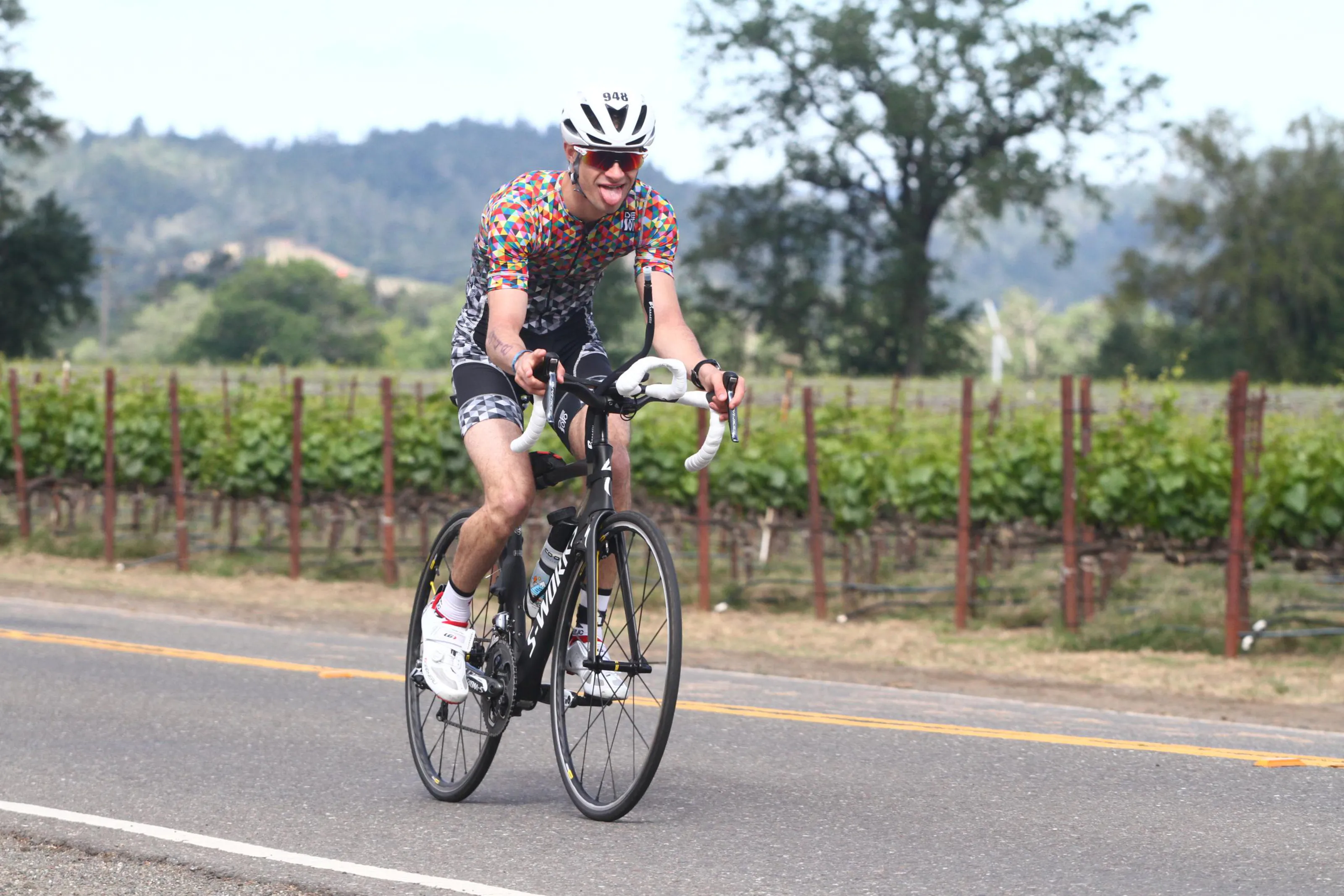

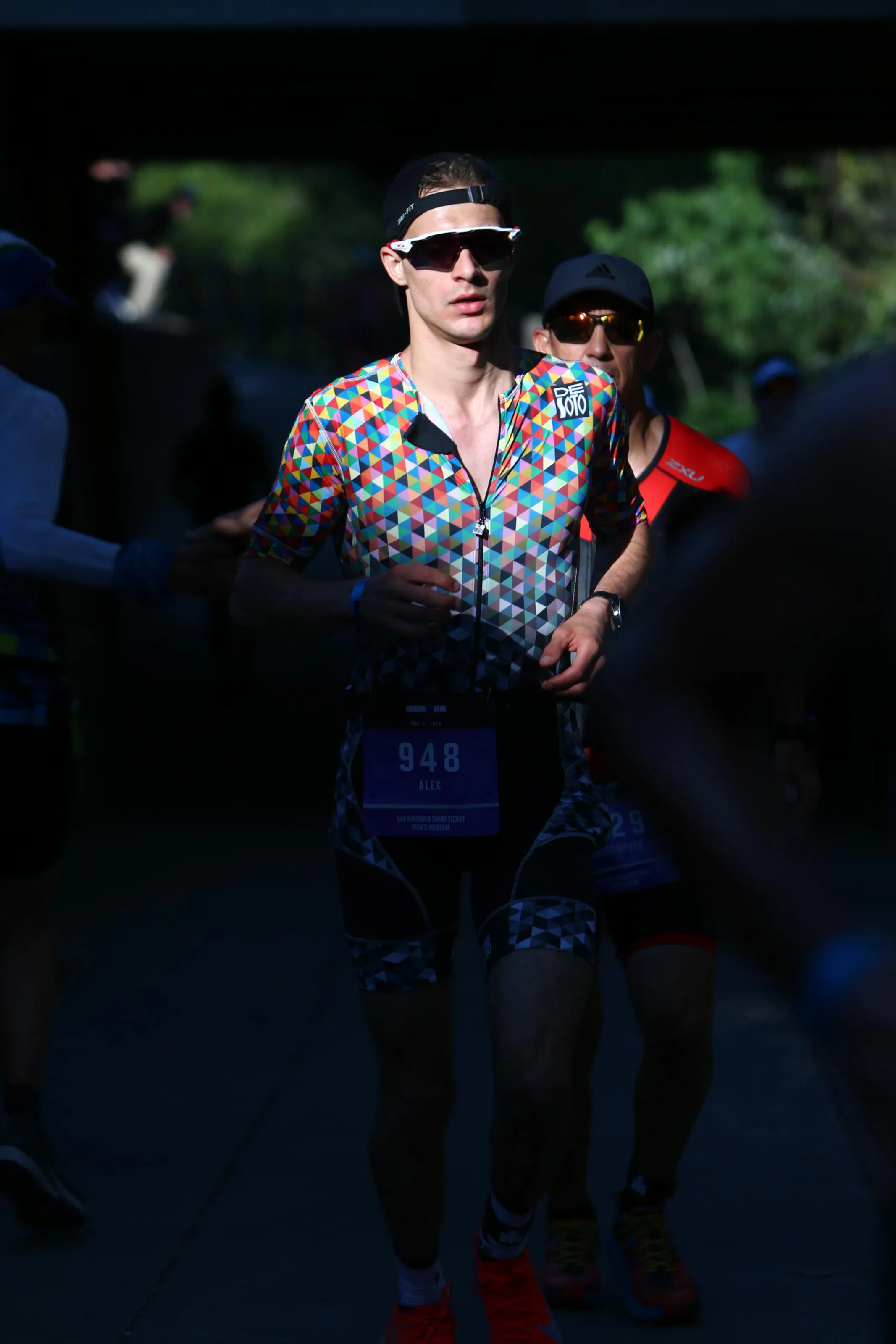
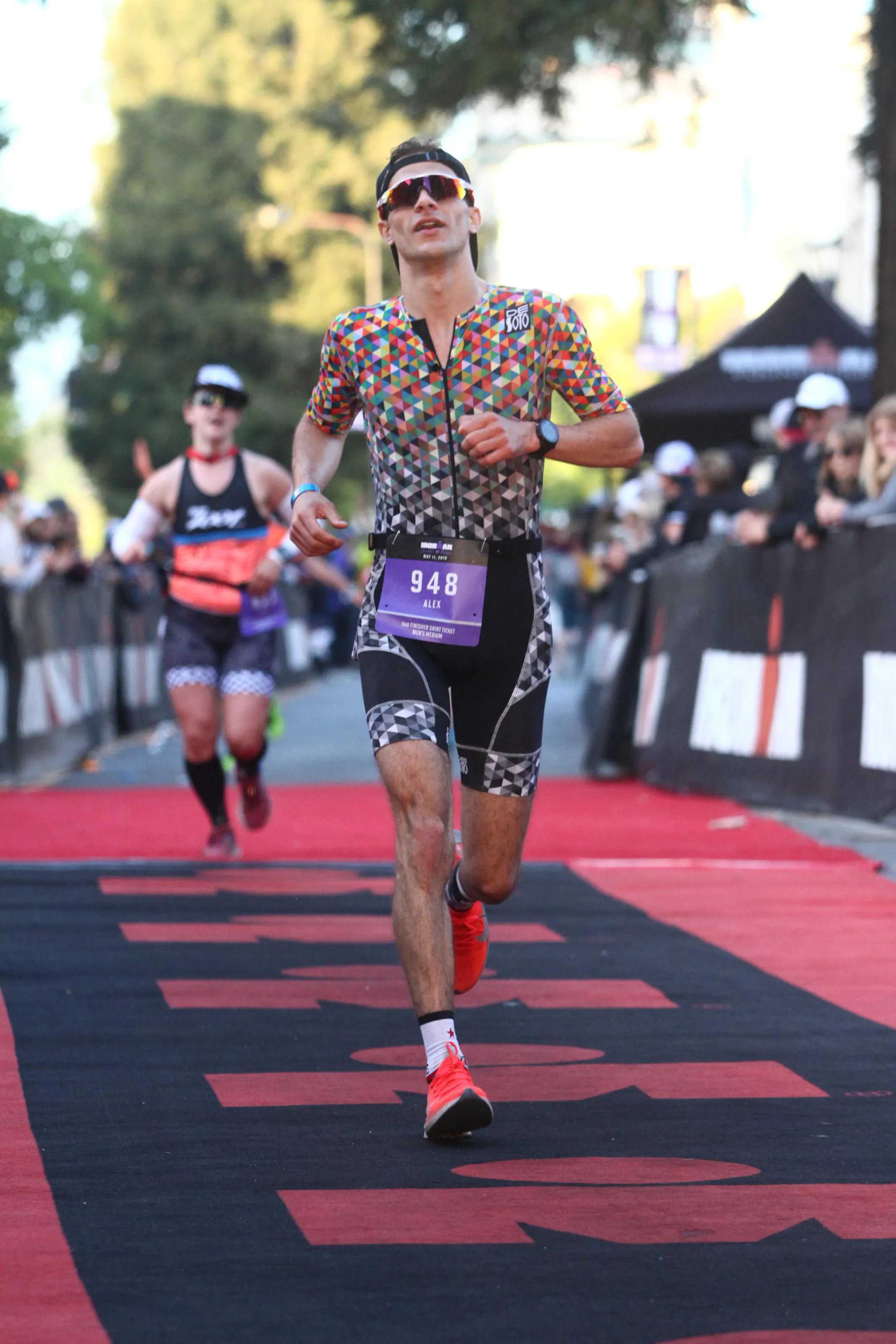
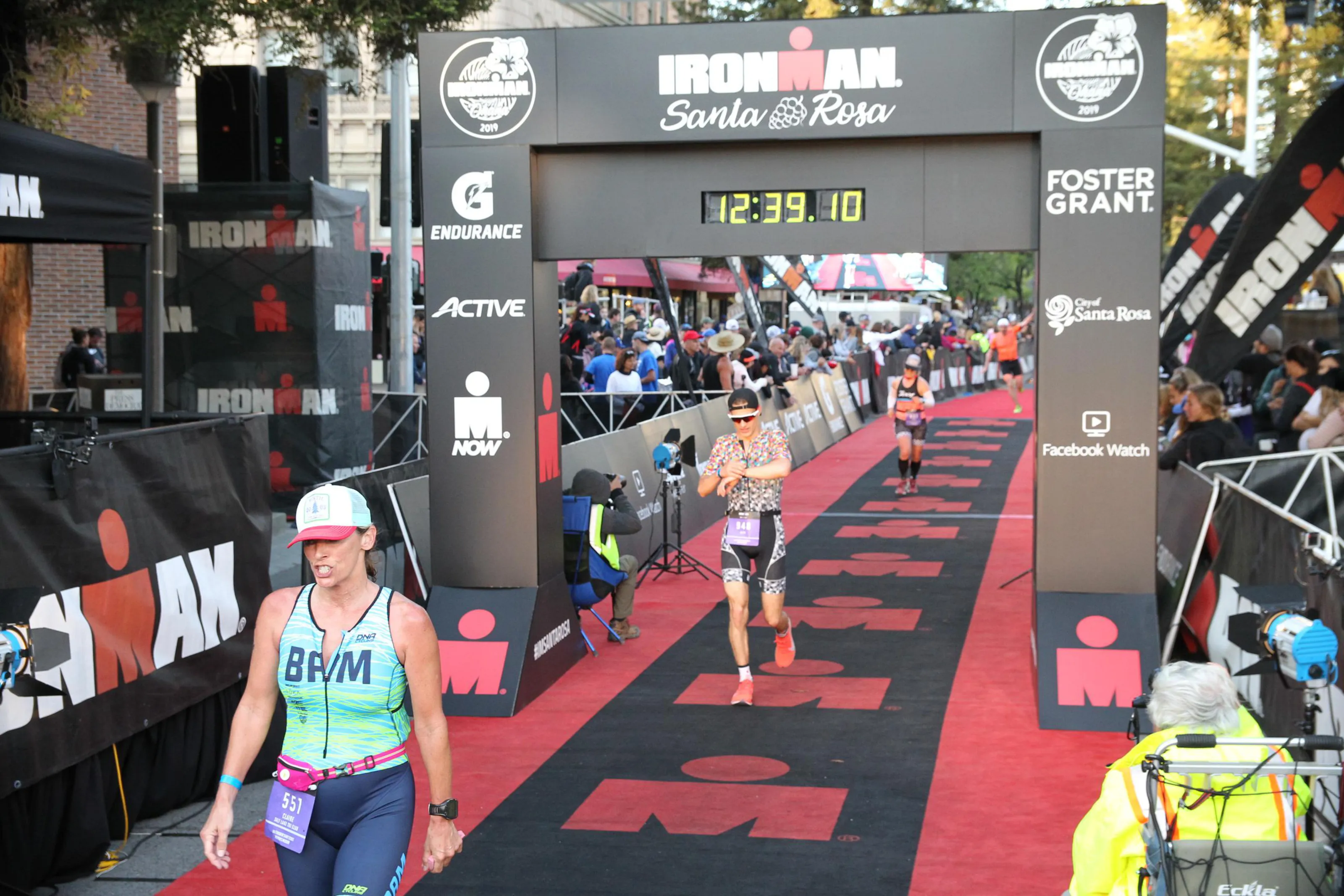
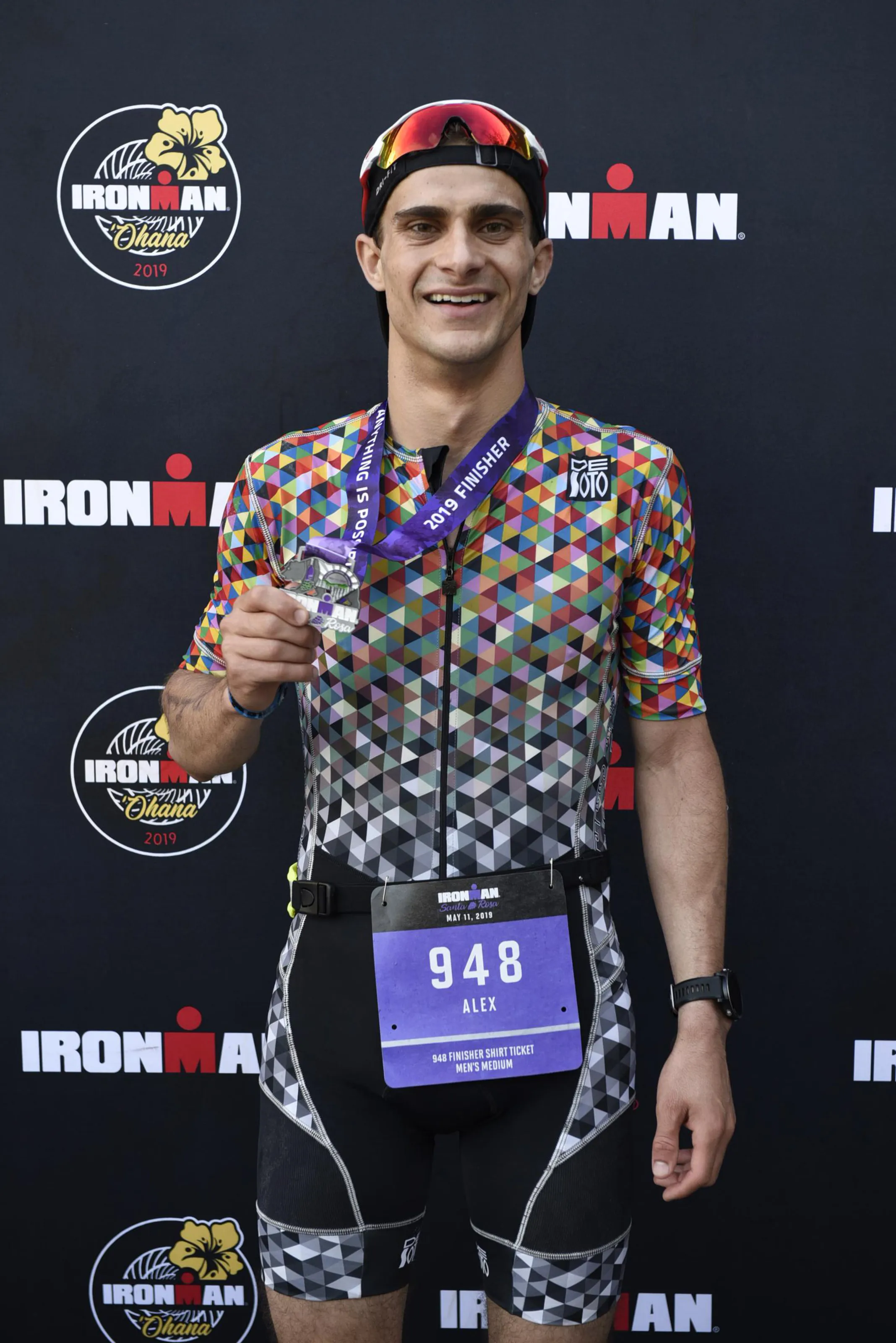
Appendix
Tips
- I’d recommend, at the very least, using a heart rate monitor during training. And if you are willing to spend money on one thing, then get a power meter. I found training with data especially helpful. It’s the easiest way to see how you’re performing and identify the areas that still need work. If you still have money to blow after those two things: bike fit, aero bars (and learn to use them), indoor trainer + Zwift, and then tri suit.
- YouTube videos are awesome for learning all about triathlon. I highly recommend Effortless Swimming for swim technique, GCN for cycling, and Triathlon Taren and GTN for all things triathlon.
- Best Bike Split is super helpful for pacing your bike leg. You enter your FTP, select or make the course, enter in some details about your bike, and it outputs the rest. You can also export the details to Zwift (so you can practice your exact power ahead of time) or Garmin (so you can display power targets during the race).
- There are many helpful benchmarks available online for estimating your race pace. Learn to do your own bike repairs and maintenance. It will keep your bike in great shape, and you’ll also save a bunch of money from having to take it to the shop.
- Carbo loading before the race is not a large pasta dinner the night before. It’s a whole week of thoughtful eating, starting the weekend before race weekend. I used this post as a starting guide for meals, which were roughly 60% carbs, 20% protein, and 20% fat.
Things to Avoid
- The sunscreen volunteers. The volunteers are all amazing and so incredibly helpful, so I don’t blame them! I blame the sunscreen. Don’t stick your arms out.
- Avoid spending lots of money. It’s easy to get carried away, but you just don’t need an aero helmet for your first triathlon. Likely not worth it.
- Don’t get a triathlon bike for your first race. I’m incredibly glad I didn’t.
- Avoid purchasing a bike quickly because you think you’re getting a good deal. Take your time to research, learn about bikes and components, test ride a few, and get a pre-fit if you can afford it. Then buy.
Race-Day Packing (Gear and Special Needs Bags)
I don’t know if this section is particularly helpful, but I wasn’t exactly sure what I should put in my Special Needs bags. So here’s a list of what I put in all my bags (* = used) and what I wish I had (highlighted):
| Bag | Items |
|---|---|
| On Bike |
|
| Morning Clothes (White Bag) |
|
| Bike Gear (Blue Bag) |
|
| Bike Special Needs (Orange Bag) |
|
| Run Gear (Red Bag) |
|
| Run Special Needs (Black Bag) |
|